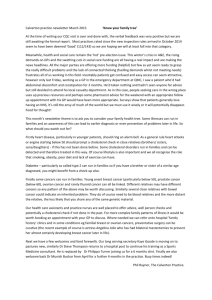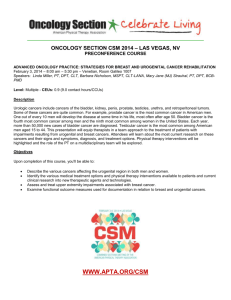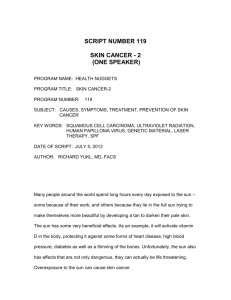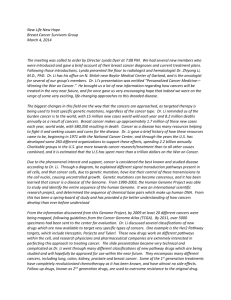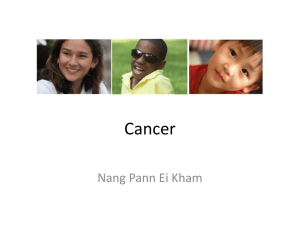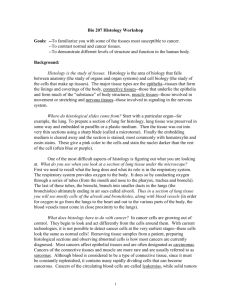TMP drop in 28.8.15 - Teams Medical Practice
advertisement
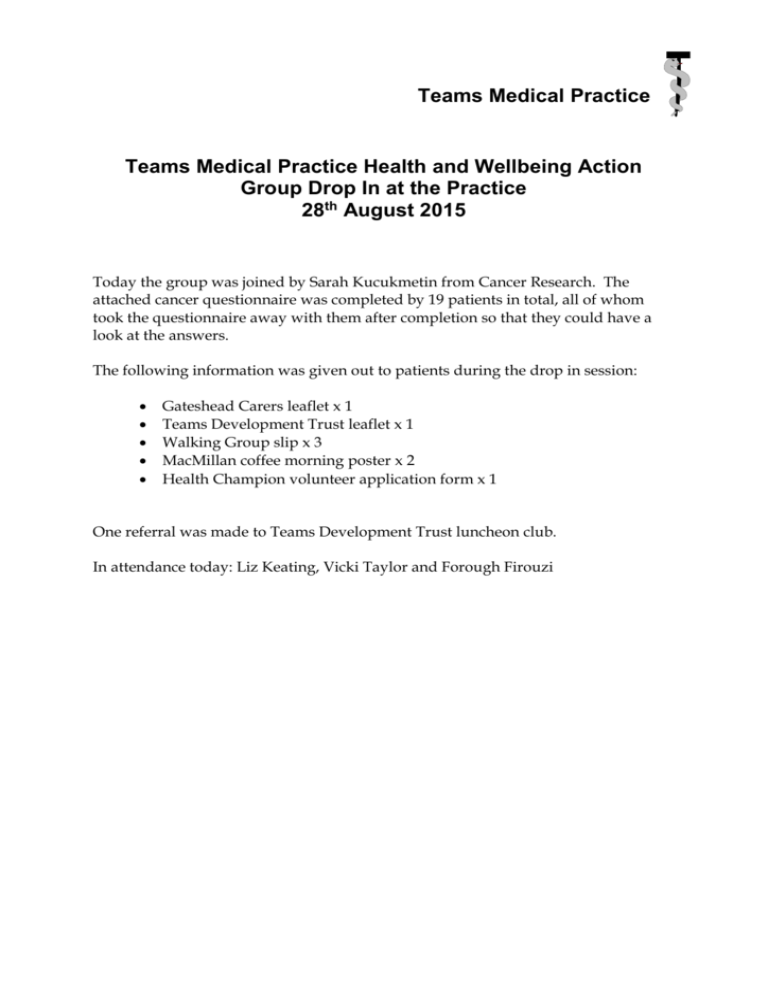
Teams Medical Practice Teams Medical Practice Health and Wellbeing Action Group Drop In at the Practice 28th August 2015 Today the group was joined by Sarah Kucukmetin from Cancer Research. The attached cancer questionnaire was completed by 19 patients in total, all of whom took the questionnaire away with them after completion so that they could have a look at the answers. The following information was given out to patients during the drop in session: Gateshead Carers leaflet x 1 Teams Development Trust leaflet x 1 Walking Group slip x 3 MacMillan coffee morning poster x 2 Health Champion volunteer application form x 1 One referral was made to Teams Development Trust luncheon club. In attendance today: Liz Keating, Vicki Taylor and Forough Firouzi Cancer questionnaire 1. Cancer is the result of uncontrolled growth of abnormal cells anywhere in the body: True False 2. How many types of cancer are ther? 50 100 300 1000 Penile Lung Lung Skin Skin Colon 3. What type of cancer kills most men? Oral Prostate 4. What type of cancer kills most women? Breast Ovarian 5. What is the most common cancer? Brain 6. Tobacco causes Leukaemia % of cancer deaths around the world? 5 15 22 41 7. Artificial sweetners are linked to certain types of cancers True 8. Foods such as Pizza False are linked to colon cancer: Shellfish Hot dogs/lunch meat Microwave food 9. ? is the most deadly of all cancers of the female reproductive system Ovarian Cervical Vaginal Uterine 10. Osteosarcoma and chondrosarcoma are cancers that affect tissues in Eyes Kidneys Throat Bones 11. Cancer of the blood cells is referred to as Kaposi Sarcoma Basal cell carcinoma Leukaemia Mesothelioma Answers 1. Cancer results from the uncontrolled growth of abnormal cells anywhere in the body (blood, brain, bone, or any organ) and many of these abnormal cells are capable of invading other tissues. Cancers are often named for the organ or cell type where the abnormal cells first develop. Terms such as liver cancer, lung cancer, brain cancer, and many others refer to where the abnormal cells started to develop. When these cancer cells leave their original developmental site they are termed metastatic cancer. 2. There are more than 100 types of cancer. Any part of the body can be affected and symptoms depend on the type of cancer and which organs contain cancer cells. Treatment of cancers may include surgery, radiation, and chemotherapy, or combinations of these treatments. 3. The most common type of cancer that kills men is lung cancer. According to the World Health Organization (WHO), the top five most common types of cancer that kill men are, in order of frequency, lung cancer, stomach cancer, liver cancer, colorectal cancer, and esophageal cancer. 4. According to WHO statistics, the most common type of cancer that kills women worldwide is breast cancer. The five most common cancers that kill women are, in order of frequency, breast cancer, lung cancer, stomach cancer, colorectal cancer, and cervical cancer. In some developing countries cervical cancer is the most common cancer found in women. 5. The most common form of cancer overall in both men and women is skin cancer. Ultraviolet light, which is part of sunlight, is the main cause of skin cancers. There are three main types of skin cancer: basal cell carcinoma, squamous cell carcinoma, and melanoma. Skin sores that will not heal and changes in appearance of the skin in localized areas such as a new growth and/or skin color changes are common warning signs of skin cancer. Such changes in the appearance of the skin that last longer than a couple of weeks should be evaluated by your physician. 6. About 22% of all cancer deaths are related to the use of tobacco and consequently, they comprise the single largest group of cancer deaths that are potentially preventable. 7. There isn't any evidence artificial sweeteners cause cancer. Other sugar substitutes such as sorbitol and stevia also apparently do not cause cancer. 8. Eating processed meats such as hot dogs and lunch meat increases a person's risk for colon cancer. The cause is not completely clear, but it may be due to nitrites and nitrates present in these foods. In addition, some studies link red meat intake to an increase risk of developing colon cancer. Other sources of protein that do not present an increased risk of cancer are foods such as chicken, fish, and beans. 9. Ovarian cancer is the most deadly of all cancers for women because most ovarian cancers are not detected early and the cancer cells have spread beyond the ovaries to the pelvis and lymph nodes when they are first detected. Unfortunately, symptoms of ovarian cancers often only appear in the late stages of ovarian cancers (late-stage cancers are difficult to treat). 10. Osteosarcoma and chondrosarcoma are cancers that occur in bones. Osteosarcoma arises most often in the knee and upper arm. Chondrosarcoma begins in the cartilage tissue associated with bones, because it acts as a pad for the bones and joints. It occurs most often in the pelvis, upper leg, and shoulders. If it contains cancerous bone tissue, it is reclassified as an osteosarcoma. 11. Cancers that result from abnormal growth of cells in the blood are termed leukemia. The majority of people diagnosed with leukemia are over 50 years old, although leukemia can occur in children. The most common type of leukemia found in children is acute lymphocytic leukemia (ALL).

